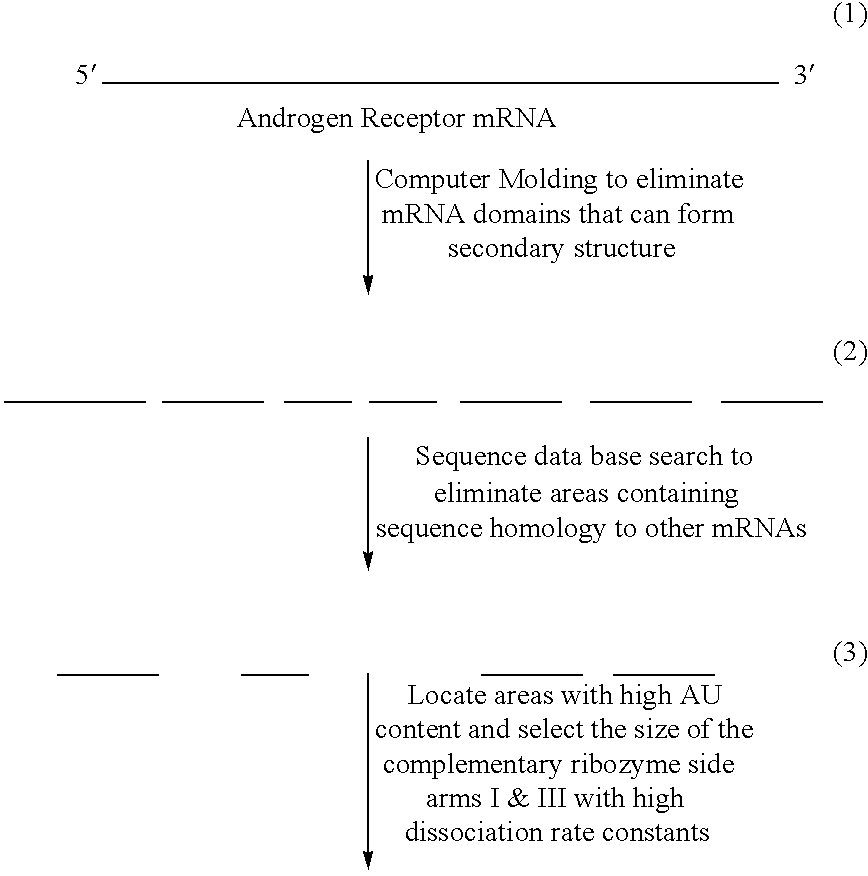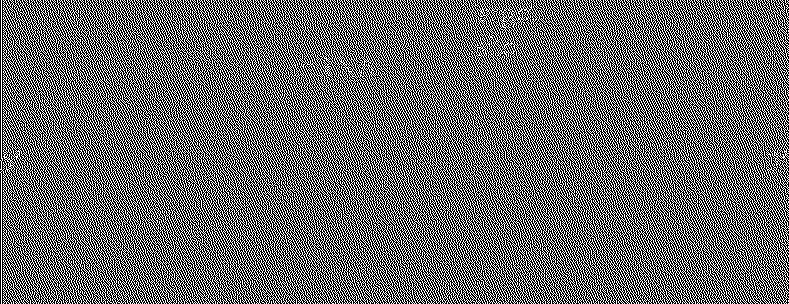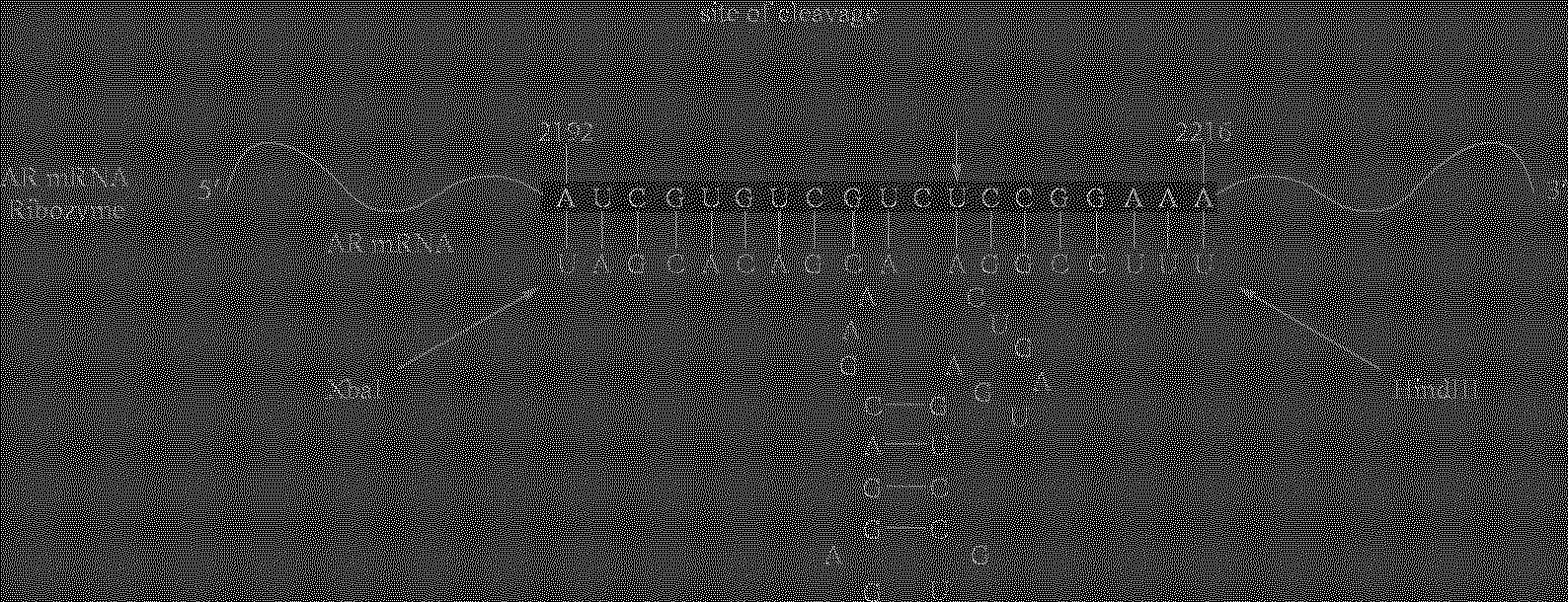Ribozyme mediated inactivation of the androgen receptor
a ribozyme and androgen receptor technology, applied in the field of gene therapy, can solve the problems of limiting the use and effectiveness of this therapy, and affecting the treatment effect of patients, so as to achieve optimal cellular efficiency, efficient cleavage, and catalytic cleavage of the rna substrate
- Summary
- Abstract
- Description
- Claims
- Application Information
AI Technical Summary
Benefits of technology
Problems solved by technology
Method used
Image
Examples
example 1
[0062]The present example demonstrates the site specificity of the synthetic ribozyme of the invention.
[0063]Two hammerhead ribozymes, H1 (SEQ ID NO:13) and HR2 (SEQ ID NO:2), cleave human androgen receptor (AR) mRNA at the GUC sequence at positions 1394 and 2375, respectively. In an in vivo assay, both of these hammerhead ribozymes, H1 and HR2, cleave the target AR mRNA substrate into two products at the expected sites. The extent of cleavage varied with the time of incubation, and the molar ratio of ribozyme to substrate. At 30 seconds of incubation at 37° C., HR2 cleaves 37% of the target mRNA at 1:1 molar ratio. Complete cleavage of the target AR mRNA by the two hammerhead ribozymes at 1:1 molar ratio occurs within 30 min. HR2 is more active than H1. A mutant ribozyme (mut-HR2; SEQ ID NO:14) and a oligodeoxynucleotide antisense (antisense HR2 oligo; SEQ ID NO:15) to the target AR mRNA sequence fail to catalyze cleavage of the AR mRNA substrate in vitro. Mut-HR2 has mutations at ...
example 2
Expression Vector with Ribozyme Gene
[0064]The present example demonstrates that the described synthetic hammerhead ribozymes are designed to cleave specifically AR mRNA within cells, as well as utility therapy in vivo.
[0065]The HR2 hammerhead ribozyme was cloned downstream of the rat U6 small nuclear RNA promoter which is transcribed by RNA polymerase III, to give U6-HR2 plasmid. Compared with pCMV-HR2, which is transcribed by pol II, U6-HR2 is more efficient in inhibiting AR mRNA and CAT activity in vivo. A 1:5 molar ratio of pCMV-AR:U6-HR2 achieved 90% reduction of CAT activity, whereas 90% reduction of CAT activity will require a 1:100 molar ratio of pCMV-AR:pCMV-HR2.
example 3
Selection of the Hammerhead Ribozyme Target Sequences in the AR Gene
[0066]The present example demonstrates the selection of AR mRNA regions targeted by hammerhead ribozymes.
[0067]The predicted primary and secondary structures of the entire AR mRNA was searched for open loops that contain the consensus sequence for hammerhead ribozyme cleavage, 5′-HUX-3′, which is cleaved 3′ of X (X can be A, C or U). RNA substrate with the GUC triplet adjacent to cleavage site was reported to yield very high cleavage efficiency compared with RNA substrate containing other triplet sequences such as CUC, GUA and AUA (Rufner, et al., 1990; Shimayama, et al., 1995; Hendix, et al., 1996). All GUC triplets in the open loop regions were tagged as potential cleavage sites for the hammerhead ribozyme. Then both sides of sequences surrounding these GUC triplets were scanned through the Genbank data base to eliminate sequences with substantial homology to other mRNAs. In order to provide more discrimination an...
PUM
| Property | Measurement | Unit |
|---|---|---|
| Length | aaaaa | aaaaa |
Abstract
Description
Claims
Application Information
 Login to View More
Login to View More - R&D
- Intellectual Property
- Life Sciences
- Materials
- Tech Scout
- Unparalleled Data Quality
- Higher Quality Content
- 60% Fewer Hallucinations
Browse by: Latest US Patents, China's latest patents, Technical Efficacy Thesaurus, Application Domain, Technology Topic, Popular Technical Reports.
© 2025 PatSnap. All rights reserved.Legal|Privacy policy|Modern Slavery Act Transparency Statement|Sitemap|About US| Contact US: help@patsnap.com



